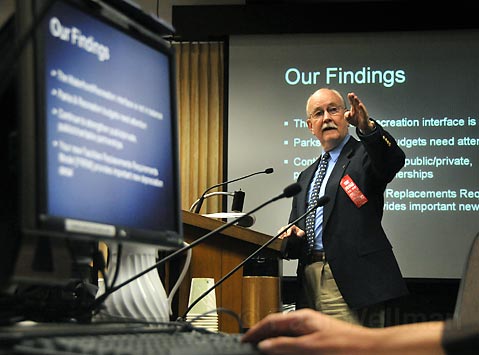City Listens to Advice from Financial Task Force
Money Is for Infrastructure

No sooner had Dudley Morris, fresh from having been praised and thanked for his work as part of the blue-ribbon Infrastructure Financing Report Taskforce, reached the last row of seats in the Santa Barbara City Council chambers on his way toward the exit, when he was assailed by Scott Gordon, who had a problem with the report’s numbers. Gordon, a boater with a slip down in the Santa Barbara Harbor, accused Morris, a former Computer Sciences Corporation managing director, of using faulty numbers in coming up with one of his suggestions on ways the city could save money. The two got into a minor spat before Morris just walked away, leaving Gordon to explain his case to a listening reporter.
What was bugging Gordon was the seven-member task force’s suggestion that the city could raise harbor fees to pay for all operations on the ocean side of Cabrillo Boulevard, thereby freeing some of the city’s Parks & Recreation Department funds for needs elsewhere in the city. Gordon argued that the city’s fees-contrary to comparisons in a task force chart-are already higher than anywhere else in the state if one counts the possessory interest tax and the $10,000 transfer fee (for a 50-foot slip, the rate being $200 per foot) to which slipholders are subject in Santa Barbara.”If the report is this sloppy in this one aspect,” said Gordon, “what else is this sloppy?”
Other task force recommendations met resistance even before the report was published. The report’s central suggestion was that $10 million a year be set aside from the city’s general fund for capital projects, compared to the current $1 million.
“You’ll have individuals and special interest groups who come up and say, ‘Oh, you’ve got to do our thing,'” task force chair Richard Jensen warned the council, adding, “You’re better off funding capital.” Most of the money should come from reducing the city’s operating costs by 2 to 3 percent annually, according to the task force, with the savings to be diverted to investment in infrastructure.
Councilmember Grant House expressed resistance to cutting services and asked if the city did not already “run a pretty tight ship.” Jensen agreed that it did. “You should have heard the department heads squeal” when task force members talked about cutting operating costs, Jensen chuckled. “They said ‘[City Administrator Jim Armstrong] is already all over us like a bad smell.'” Jensen also praised the city for “doing an excellent job in using credit, accumulating capital funds, and investing wisely.” However, he pointed out that in going solar for some of its energy use, the city “did a green thing” but did not manage to save any money. “All people and purchases” should be looked at with a view to savings, Jensen said.
Besides catching up on a $19 million backlog in deferred maintenance, the city should prioritize, according to the task force, “several major infrastructure needs which stick out like ‘sore thumbs’ and are critical to the quality of life and Santa Barbara’s well-being,” starting with a larger and more modern police station, upgraded police locker rooms, and fire station upgrades (including fire sprinklers). After emergency services facilities, priorities included rehabilitation of the municipal tennis court, an additional or larger swimming pool at Los Ba±os, cleaning up East Beach and the Bird Refuge, rehabilitating the Westside Center, and installing new carpet and landscaping at the library. Jensen and Morris emphasized that Santa Barbara’s well-kempt beauty is also its bread and butter, given its reliance on tourist dollars and property values. The report’s introduction reminded the council that the city’s capital aspects would be one of its “most important legacies” to future generations.
The city could consider a voter-approved general obligation bond for large projects such as parks or the police station, Jensen said, adding that if voters failed to approve either Measure A or Measure G, the city should also consider a half-cent sales tax of its own to maintain current tax revenues.


